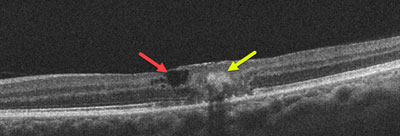What is macular telangiectasia?
Macular telangiectasia is an uncommon bilateral retinal disorder affecting the paracentral macula. It occurs in about 1 out of every thousand people and usually starts in the fifth to seventh decades of life. Many patients are completely asymptomatic, although some can develop central blurriness or distortion.
The cause is unknown but probably includes primary Muller cell dysfunction (an important retinal cell responsible for retinal support and function) with secondary vascular and retinal tissue loss.
How is macular telangiectasia diagnosed?
Macular telangiectasia is detected during a dilated ocular examination. Macular changes include retinal pigment clumps, inner retinal crystals, and a whitish retinal discoloration. OCT scanning and fluorescein angiography are often used to confirm the diagnosis. Patients are often misdiagnosed as having age-related macular degeneration since the findings can appear somewhat similar.

Pigment clumps with a whitish discoloration are seen to the right of the macular center.

OCT scanning shows a loss of inner macular tissue (red arrow) and pigment migration (yellow arrow).
How is macular telangiectasia treated?
There are no specific treatments for the underlying degenerative changes, although most patients do well. There is a small chance of new blood vessel growth below the retina (macular neovascularization) that can cause more severe central vision problems. Patients are therefore asked to check their vision regularly with an Amsler grid and see their eye doctor emergently if any changes develop. This can be treated in a similar manner as for patients with wet age-related macular degeneration.
View more retina images at Retina Rocks, the world’s largest online multimedia retina image library and bibliography repository.



